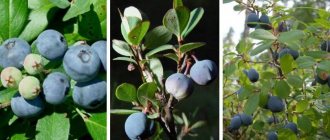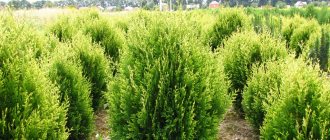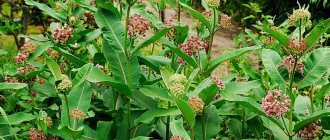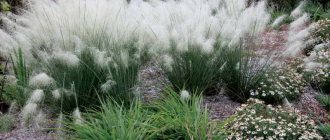Description of folded thuja Vipcord
This variety of folded thuja has long, hanging shoots that resemble ropes, which is how it got its name - “whipcord”, which means “twine” in English. The shoots are covered with shiny needles in the form of scales, tightly adjacent to each other. In summer the needles are green, but in cold weather they become an unusual bronze color. The shrub has a shallow root system that is sensitive to soil compaction. The description of thuja Vipcord notes its unpretentiousness.
Brief information about the variety
- Color : green needles in summer, bronze in winter.
- Height : up to 30-50 cm.
- Crown width : about 60 cm, in adult plants it can reach 1.5 m.
- In which regions does it grow : Central, Volga-Vyatka, Ural, North-Western regions.
- Planting features : in the shade, singly and in groups.
- Immunity : high.
- Life expectancy : up to 200 years with proper care.
The use of folded thuja Vipcord in landscape design
The Vipcord variety is widely used in landscape design. It can be used to create hedges and complement rock gardens, mixborders, and rockeries. Thanks to its excellent compatibility with other ornamental plants, Thuja Vipcord looks good in a variety of compositions. This thuja looks no less successful in single plantings. It becomes especially attractive when grown near small ponds and rocky areas. It is often used in container plantings. According to reviews from gardeners, Thuja Vipcord looks unusual in topiary.
The photo of thuja folded Vipcord shows how harmoniously it combines in landscape design with architectural elements made from various natural materials and with other coniferous plants.
Description of the variety
Vipcord belongs to the folded varieties of thuja. Under natural conditions, these trees can reach gigantic sizes and grow up to 60 meters in height, and sometimes higher. Decorative varieties are not large in size; they were bred specifically for decorating gardens and parks. These small trees have a fluffy crown.
They look perfect in contrasting compositions and single plantings. Folded thuja Vipcord is a dwarf ornamental variety and is used in garden and park design. The shrub has a spherical crown with long cord-like branches hanging down.
This coniferous plant has scale-like needles, pointed at the ends. In summer the needles are dark green, in winter they take on a brownish tint. The height of the bush varies from 50 cm to one meter.
Thuja is classified as a frost-resistant variety, but this quality is conditional. The shrub will not tolerate harsh winters, so it is insulated for winter. Thuja grows very slowly. In ten years it grows to only 30 cm. Vipcord grows by no more than 10 cm over the course of a year. Decorative varieties of thuja, including Vipcord. used in landscape design. From fluffy spherical bushes they create an original hedge.
Features of reproduction
Thuja of this variety is propagated mainly vegetatively. The reproduction algorithm consists of the following points:
- dig up the ground in the area where the cuttings will take root, add peat, and pour a layer of sand on top;
- at the end of June, break off shoots from the plant, soak them in a root formation stimulator;
- plant the cuttings to the depth of the sand layer at a slight angle;
- Cover each cutting with a transparent plastic bottle or glass jar like a greenhouse.
Next spring, the rooted plants can be transplanted into open ground.
Attention! You can grow thuja Vipcord using cuttings at any time of the year. In winter, cuttings are rooted in boxes in a warm room.
Propagation by seeds of this variety of thuja is used very rarely - this complex process can take up to 6 years. In addition, not all young bushes obtained from seeds inherit the varietal characteristics of the original plant. In early spring, the seeds are left in a container with water for 12 hours, after which they are laid out on damp sand. As soon as the sprouts appear, they are transplanted into individual containers and grown until planted in open ground.
Planting and caring for folded thuja Vipcord
There is nothing complicated in planting thuja Vipcord: it does not have any special requirements for light or soil composition. Cuttings with a closed root system usually take root well if simple planting techniques are followed. In general, the cultivation of thuja Vipcord is subject to the same rules as the cultivation of other varieties of this crop.
Recommended timing
The most suitable season for planting thuja is spring. Planting can begin in April, when the soil has warmed up sufficiently, and already in May the young seedlings will actively begin to grow. However, the unpretentious variety Vipcord can be planted throughout the season until mid-autumn. In regions with cold winters, it is recommended to avoid autumn planting so that the plant has time to take root and gain strength for wintering.
Attention! Thuja Vipcord, planted in summer, more often suffers from various diseases and pests.
Site selection and soil preparation
Thuja Vipcord is quite unpretentious - it grows equally well both in illuminated places and in shaded conditions. However, you should avoid exposing the crown to direct sunlight. The shrub does not suffer from strong winds and tolerates winter frosts well. It can grow on any soil, but fertile, water- and breathable, moderately moist substrates are best suited. In conditions of insufficient humidity, the crown thins out.
The area for planting thuja Vipcord is dug up, sand is added to too heavy clay soils. It would also be useful to enrich the substrate with peat and add leaf or turf soil.
Landing algorithm
Planting thuja Vipcord is not difficult and is carried out using the following technology:
- dig a planting hole 2 times larger than the size of the root ball;
- water it daily for two weeks;
- prepare a mixture of peat and sand;
- place the seedling in the hole and cover it with soil mixture;
- water well.
Landing
When planting live bait you will need:
- Prepare the mixture from peat and coarse-grained sand or vermiculite taken from the ground.
- The cut live bait is immersed with the lower part in a growth stimulator. You can use Kornevin or another drug. The winding time may correspond to the instructions on the packaging.
- Mix the prepared soil into the potters.
- Place live bait in it. A pot with a diameter of 15 cm can accommodate 6-7 live bait. The stench must be installed strictly in a vertical position.
- This requires a warm location with sufficient amount of sunshine. The rooting process takes approximately 3 months.
- It is necessary to periodically mix the soil with a spray bottle or watering can.
When planting plants:
- Remove it from the refrigerator.
- Fill the container with a starting mixture consisting of three parts peat moss, one part fine bark and one part vermiculite or perlite.
- Sow the seed in it and sprinkle the animal with a ball of sand with a quantity of 1-2 div.
- For successful germination, the required temperature is between +12°C and +15°C.
- Sumish, in the way the plant is planted, it is guilty of being permanently hairy, if not Syrian.
- Before you give up, you will need 6-8 years of development today.
As long as the first fate unfolds, the size of the seedlings will not be even greater. In three cases, they definitely need to be pricked. And in a permanent place, the Vipcord seedlings can be planted on 4-5 rocks.
Before you plant young thuja in the open air, you need to adapt it to the climate. For this purpose, let the container with the gardenings sit in the open air for a couple of years. The place must be protected from wind and falls. It will be necessary to prepare it close to summer, so that you can increase the hour of drying in the open air by 1 year.
Selecting and preparing a place for planting
Thuja can grow in the water. It will be better if you choose a dormouse. As far as the ground goes, then there you go, come what may. The same goes for the stone-cutter. The best crop will develop in well-drained, neutral or slightly moist soil with an acidity level of 6.8–7.2 pH.
Important! Please show me that Vipcord
-
this is not a variety, but a mutation, so when grown from the plant, the probability of obtaining exactly the same plant as the one from which the cones were collected does not exceed 50%.
You can slightly acidify the soil by adding compost or rotted pus before planting. You want the soil to be deprived of moisture and looseness. This effect can be achieved with a ball of mulch. The soil must be removed by evaporation, and the soil by compaction.
Landing rules
The optimal time for gardening is early spring. At this hour, the earth’s minds have already been created so that the roots can develop. And the wind temperature axis does not support the growth of the growing season, so you can concentrate all your efforts on rooting.
Also learn how to propagate thuja at home.
Planting thuja pokrokovo:
- Choose a dormouse plot with drained soil.
- Remove the weeds from the planting area. Dig the soil to a depth of 0.3–0.5 m.
- Dig a hole 2 times larger than the diameter of the root ball.
- If necessary, create a drainage ball in it using pebbles or crushed stone. Tovshchina sharu - 15 div. If the soil is not fertile enough, mix the enriched soil with a bucket of compost.
- Place a portion of the soil mixed with compost on the drainage ball or at the bottom.
- Remove it from the container in which it arrived from the distributor. Look around the root. If necessary, separate them so that they can easily master the excess soil.
- Place the sajanets in the center of the pit.
- Fill the hole with soil. Make sure that the thuja is planted 3-4 cm deeper and that the bottom grows in the weed.
- Apply a small amount of excess soil to the tree so that it can be watered manually.
- Water the sardzhanets with rye. Then continue watering once a week.
Rules for growing and care
The agricultural technology for growing this variety of thuja is very simple: the plant needs regular watering, infrequent feeding, minimal pruning, loosening or mulching and preparation for winter. Thuja Vipcord can grow on its own, but with good care its crown looks especially picturesque.
Watering schedule
The superficial root system of Thuja Vipkord is very sensitive to drying out of the soil, so watering is the most important part of caring for the plant. Young bushes are watered once every 7 days at the root. Within 30 days after planting, the seedling needs to sprinkle the crown. It is carried out in the evening, when direct sunlight does not reach the wet shoots. Older bushes are watered less often, once every 10 days is enough, and sprinkling can be done only from time to time.
Top dressing
During the first three years after planting, thuja Vipcord does not need to apply fertilizers, then it is enough to feed the plants with potassium and phosphorus compounds. They are applied twice a year during active growth - in spring and summer. It is also good to use special complexes for coniferous plants. Fertilizers are dissolved in water for irrigation, scattered on tree trunk circles or applied during regular loosening.
Attention! Since thuja Vipcord is a slow-growing shrub, it does not require a large amount of fertilizer. Exceeding the dosage may lead to poor plant growth.
Trimming
Like all thujas, the Vipcord variety tolerates pruning well. In the spring, sanitary pruning is done - all damaged, dried and frozen shoots are removed. Due to its slow growth and natural spherical crown shape, this shrub usually does not need formative pruning. However, plants of this variety can be given the desired appearance using decorative pruning. Most often, the crown of standard forms of folded thuja Vipcord is formed, for example, as in the photo:
Preparing for winter
The shrub of this variety tolerates frosts well down to -8 °C, so in mild winters, adult thuja Vipcord plants do not need to be covered. Regardless of the climate, the trunk circles are mulched before winter so that the surface root system of the thuja is not damaged. Spruce branches, large wood chips, and leaves are suitable as mulch. The best shelter for thuja will be a thick snow cover, but in winters that are too cold or with little snow, the shrubs are hidden under burlap, cardboard boxes or other insulating material.
Attention! After planting, young plants must be covered for the winter.
The covering material is removed at the moment when the spring sun begins to warm up. If night temperatures can damage the needles, cover the plants every evening.
Landing
When planting cuttings you will need:
- Prepare a mixture of peat, coarse sand or vermiculite, taken in equal parts.
- Dip the cut cuttings with the bottom part into a growth stimulator. This could be Kornevin or another drug. The holding time must comply with the instructions on the packaging.
- Pour the prepared soil mixture into the pots.
- Plant cuttings in it. A pot with a diameter of 15 cm contains 6–7 cuttings. They must be installed strictly in a vertical position.
- Thuja requires a warm room with enough sunlight. The rooting process will last about 3 months.
- Periodically it is necessary to moisten the soil with a spray bottle or watering can.
When planting seeds:
- Remove the seeds from the refrigerator.
- Fill the container with a starting mixture of three parts peat moss, one part thin bark and one part vermiculite or perlite.
- Sow seeds into it and sprinkle a 1–2 cm thick layer of sand on top.
- For successful germination, an air temperature of +12°C to +15°C is required.
- The mixture in which the seeds are planted should be constantly moist, but not soggy.
- It will take 6–8 weeks of seed development for seedlings to appear.
During the first year of development, the size of the seedlings will not be too large. At three years old they definitely need to be dived. And Vipcord seedlings can be planted in a permanent place at 4–5 years.
Before planting a young thuja outdoors, you need to adapt it to the climate. To do this, the container with seedlings is taken out into the open air for a couple of hours every day. The place must be protected from gusts of wind and precipitation. Hardening will take about a week if you increase the time spent in the air by 1 hour every day.
Selecting and preparing a landing site
Thuja can grow in partial shade. But it will be better if you choose a sunny area. As for the soil, it can be anything. Rocky ones are also suitable. However, the crop will grow best in well-drained, neutral or slightly alkaline soil with an acidity level of 6.8–7.2 pH.
Important! Please note that Vipcord is not a variety of thuja, but a mutation, so when grown from seeds, the probability of obtaining exactly the same plant as the one from which the cones were collected does not exceed 50%
You can slightly acidify the soil by adding compost or rotted manure before planting. You want to keep the soil moist and loose. This effect is ensured by a layer of mulch. It will protect moisture from evaporation and the soil from compaction.
Landing rules
The optimal time for planting is early spring. At this time, conditions have already been created in the soil so that roots can develop. But the air temperature is not conducive to the beginning of the growing season, so the thuja can concentrate all its efforts on rooting.
Also find out how to propagate thuja at home.
Planting thuja step by step:
- Choose a sunny site with well-drained soil.
- Remove weeds from the planting area. Dig up the soil to a depth of 0.3–0.5 m.
- Dig a hole 2 times the diameter of the root layer.
- If necessary, create a drainage layer of pebbles or crushed stone in it. The layer thickness is 15 cm. If the soil is not fertile enough, mix the removed soil with a bucket of compost.
- Place some of the soil mixed with compost on the drainage layer or at the bottom of the hole.
- Remove the thuja from the container in which it arrived from the nursery. Inspect the roots. If necessary, untangle them to make it easier for them to explore the surrounding soil.
- Place the seedling in the center of the hole.
- Fill the hole with soil. Make sure that the thuja is planted 3–4 cm higher than it grew in the nursery.
- Make a small mound of soil around the tree to make it easy to water.
- Water the seedling generously. In the future, continue to water once a week.
Pests and diseases
One of the most serious diseases of thuja is late blight. The fungus infects the plant and leads to its slow death. This disease is extremely difficult to treat, so most often diseased bushes are burned and the soil is changed to avoid infecting other crops. Plants whose root system does not receive enough air and rot from excess moisture are susceptible to late blight. To prevent this disease, the soil is loosened or mulched.
Like all types of thuja, Vipcord can develop rust, which causes the shoots and needles to turn brown. The plaque is cleaned off or the affected parts are removed, and the plant is treated with fungicides.
If the thuja is attacked by insects, Karbofos or other insecticides will help to cope with them. In the description of Thuja Vipcord, it is noted that of all the pests, the cockchafer is especially dangerous. As soon as the first insect is noticed, the crown should be treated with special preparations, which include imidacloprid. Such treatments are repeated every 1.5 months throughout the spring-summer season.
A good preventative measure is to periodically spray the plantings with Bordeaux mixture.











